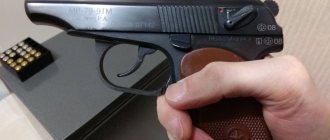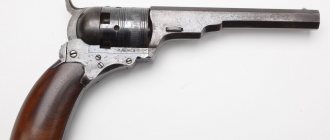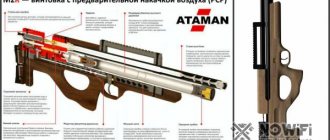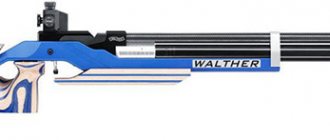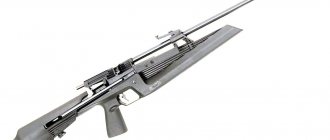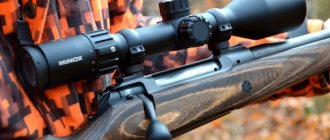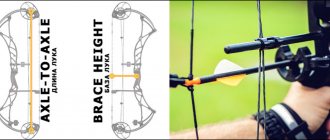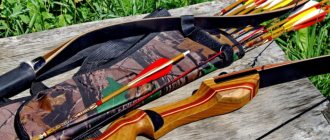The exact date of creation of a firearm called a pistol is unknown. Place of creation too. If you believe modern researchers, the word “pistol” has French roots, and according to other sources, it has Slavic roots. “Pishchal” is nothing more than a pipe. It was metal tubes that were used to make the first small arms.
Danila climbed with a backpack into the attic of an abandoned house in Manhattan. There was desolation all around, which is so necessary today. He pulled out a piece of wood he had picked up on the street, a coil of wire and a copper pipe. Using a knife, I made a primitive stock, fitted the tube and tied it tightly with wire. He clamped the back end tightly, making a small hole in it. Then he filled the tube with a mixture of saltpeter, manganese and sulfur, and sprinkled scraps of nails on top. The "pistol" was ready!
Many people remember the scene from the movie “Brother-2,” but not everyone knows that the first real pistol had a similar origin story.
Things from days gone by
Miniature copies of muskets became widespread in the 15th century AD. According to available information, the trendsetters were Italians (from the city of Pistoia, which is an additional argument), but this is only one of the versions.
Most likely, they simply put production on stream. But, in any case, soon the brilliant French nobles began to actively shoot their rivals in the boudoir of Parisian beauties.
D'Artagnan's ancestors borrowed this innovation from German mercenaries captured by the troops of Henry II in the battle with Italian troops at Ranti in 1554.
At that time, the weapon was equipped with a wick fuse (or lock), and although it was more comfortable to carry, it did not load much faster.
https://www.youtube.com/watch?v=pV0CalRL-Z4&t=13s
Most often, pistols were used by cavalrymen; holsters with loaded pistols were hung from the saddle.
Next step
In the 16th century, the inconvenient and dangerous wick was replaced by a wheel mechanism (according to legend, Leonardo Da Vinci himself had a hand in creating such mechanisms). The structure was started using a key.
This made it possible to avoid misfires, but complicated the loading process. Despite the simplification of the design over time, wheel locks remained extremely complex and expensive to manufacture, therefore, despite their reliability, they gradually gave way to other methods of ignition.
It is worth noting that some of the pistols already at that time acquired the semblance of unitary cartridges; it was not the pistols themselves that were charged, but separately inserted charging chambers; to reload such a pistol, you only had to change the chamber and cock the mechanism with a key.
In the 17th century, the wheeled mechanism was replaced by a flintlock mechanism, the essence of which was the hammer hitting the flint in the lock.
The carved spark ignited the gunpowder fuse in the breech (to be fair, such a mechanism was originally tested on guns). The pistols were, naturally, smoothbore. Although there were also rifled ones, in this case they were made by masters, and therefore extremely rare.
Already at the beginning of the 19th century, a capsule, a cap with a flammable composition, appeared. In view of this, the flintlock mechanism left the scene, since ignition using a primer was more convenient and faster. Initially smooth-bore, with the development of industry, pistols also received rifled barrels, which made it possible to improve the accuracy of the battle and increase the effective firing range.
Since the mid-twentieth century, weapons - pistols and revolvers - have taken another step towards increasing the rate of fire and multiple charges.
9.Heckler and Koch USP
- Country of origin
: Germany - Developed
: 1989-1993 - Weight
: from 0.667 to 1.08 kg (depending on modification) - Length
: from 173 to 240 (depending on modification) - Barrel length
: from 91 to 153 mm (depending on modification) - Initial bullet speed
: from 270 to 350 m/s (depending on caliber) - Magazine capacity
: from 8 to 18 (depending on pistol modification and caliber) rounds
The weapon was developed by a German manufacturer in 1993. Relatively good reliability, well-known German quality and good shooting accuracy made this pistol a member of the top with the ninth position. The manufacturer offered nine different modifications. The main disadvantages are the huge dimensions, as well as the inconvenient shutter. Despite this, this weapon has received its place in the list of the best pistols in the world.
Pistols and revolvers
The desire for speed of fire led to the creation of the revolver. The first samples were created back in the 16th century. The essence of the invention was the use of a rotating (translation of the word revolver) drum with charges.
But, in the presence of a flintlock, it was cumbersome and had the same problem with the constant addition of gunpowder to a special shelf to ignite the main charge and did not provide continuous firing.
The time of revolvers came in the 19th century.
At the beginning of the century, officer Artemas Wheeler from the United States officially documents the invention of a pistol with a cylinder and a percussion flintlock. A little later, the Englishman Collier presented an improved model in London.
The presence of a powerful spring in the form of a plate (a prototype of a mainspring) pushed the drum tightly and prevented breakthroughs of powder gases. A gun with a similar reloading mechanism was also presented.
This weapon was interesting, but too expensive and did not become widespread in Europe.
However, the design features were taken into account by gun specialists.
With the invention of the capsule, which ensures relatively continuous firing and machine-tool production of weapon components, which significantly simplifies and reduces the cost of work.
In 1836, a certain Mr. Pearson sold the invention of a pistol with a revolving mechanism for feeding cartridges to Colonel S. Colt in the same USA. Samuel established the mass production of capsule revolvers, known today as the Colt “Peacemaker,” and will forever remain in the memory of grateful humanity.
Soon American revolvers replaced similar single-shot types of weapons throughout the world. In the modern United States, there is a proverb about this: “God created people as they are, and only Colonel Colt made them equal.”
2.SIG-Sauer P226
- Country of origin
: Germany, Switzerland - Developed
: 1981 - Curb weight
: 0.802 or 0.867 (depending on the cartridges used) kg - Length
: 196 mm - Barrel length
: 112 mm - Magazine capacity
: 12, 13, 15, 17, 18, 20 rounds (depending on the cartridges used)
This weapon has a unique history. The high position in the ranking is deserved because the pistol has been approved by various armies and intelligence agencies around the world. As a result of cooperation between SIG and Sauer, the Sig-Sauer P226 pistol appeared on the market. Back in the middle of the last century, the P220 model was manufactured, and it was this model that was used as the basis for the production of the P226. Gunsmiths note the thoughtfulness of the design and the excellent quality of execution of the smallest details. If you need to use a small pistol, this model will not work. If you look at the photo of the SIG-Sauer P226, you might get the impression that it is light, as if made of plastic. This is far from reality. In fact, the gun is quite large and heavy. In the hands of professionals, the relatively large dimensions and good combat power make the weapon indispensable. The manufacturer of the SIG-Sauer P226 has been creating excellent, high-quality weapons for many years. The use of new developments is the main key to the company's success. The pistol was created back in 1981 as a competition item for the American army. Perhaps the most important disadvantage of this pistol is its high cost, which did not allow it to take first place in the list of the best firearms.
Self-loading competitors
The hegemony of revolvers was interrupted by the invention of a semi-automatic type of reloading. In a weapon using innovation, the cartridge was fed from a box magazine into the breech through the use of powder gases, rather than the physical rotation of the drum.
The first sample appeared in 1892 in Austria-Hungary, manufactured by the Steyer arms factory. Subsequently it entered service with the cavalry units of the Austro-Hungarian army.
Subsequently, self-loading pistols took their perhaps main place in the history of small arms. And now about the differences in designs.
6.Colt M1911
- Country of origin
: USA - Developed
: 1911, modification M1911A1 – 1926 - Weight
: 1.12 kg - Length
: 216 mm - Barrel length
: 127 mm - Initial bullet speed
: 252 m/s - Magazine capacity
: 7 rounds
Legendary and at the same time one of the oldest pistols of our time, one might say, a weapon with history, which is already a reason to include the weapon in the rating. It was actively used in the US Army for more than seventy years, but was replaced by a pistol from the Italians called Beretta 92. During its entire existence, it is considered one of the most popular, and experts note the presence of a large number of fakes. A small magazine and relatively heavy weight do not allow it to go beyond sixth place in this ranking.
Similarities and differences
Both types of weapons have a frame with a barrel, but unlike a revolver, a self-loading pistol may have an unsecured (free) barrel. The frame has a built-in housing with a trigger mechanism. Revolvers do not have a bolt with a spring and other components (ejector, bolt, etc.). Accordingly, an absolutely excellent cartridge feeding mechanism.
For revolvers, cartridges are located in chambers (special compartments) of the drum, and for self-loading (automatic) pistols, in magazines. The location of the magazine can be different, both in the handle and in a separate part of the weapon. The supply of ammunition is carried out by powder gases.
7.Walther P99
- Country of origin
: Germany - Developed
: 1994-1997 - Weight
: 0.7 kg - Length
: 180 mm - Barrel length
: 102 mm - Initial bullet speed
: 375 m/s - Magazine capacity
: 10 rounds
The manufacturer of this pistol has long been considered an innovator in the world of weapons and pistols in particular. This model was first released from the assembly line in 1994, after which it became widespread. Manufacturers tried to create weapons that would incorporate the latest technology and excellent quality. After its release, the Walther P99 pistol became a real sensation, because the company had previously been involved in the production of classic weapons. All these advantages made it possible for the Walther P99 to enter the top 10 best pistols in the world and take seventh position. Optimal weight, a pleasant and comfortable grip and balanced dimensions make the gun convenient to use. During production, the weapon received several modifications.
Cartridge
Revolving cartridges are distinguished by the presence of a rim, and, as a rule, by increased power, since placement in the chambers of a drum, without the presence of moving parts, limits the strength of the designer less. But now these lines are blurring, revolvers can be designed for a pistol cartridge, but in this case the cylinder requires more complexity to securely fix the cartridge in the chamber.
Pistol cartridges may differ in design, such as a hidden flange or a semi-protruding one, the fact is that flangeless cartridges are more suitable for use in box magazines. But at the same time, unlike revolver cartridges, the power of a pistol cartridge cannot be increased unnecessarily; this will lead to rapid wear of the rubbing parts of the pistol.
The most famous pistol cartridges are used - the iconic US pistol - Colt M1911, 11.43 mm cartridge, M9 pistol, 9 mm Para Luger cartridge, 9x18 mm PM cartridge.
8.Desert Eagle Mark XIX
- Country of origin
: Israel, USA - Developed
: 1983 - Weight
: from 1.7 (aluminum) to 2 (steel) kg - Length
: 273 mm (with barrel length 152 mm) - Magazine capacity
: from 7 to 9 (depending on caliber) rounds
This pistol was specially created with a large barrel diameter. It is designed for the maximum caliber . 50 (12.7 x 33 mm). The Desert Eagle, chambered in .50 Action Express, has a muzzle energy of 2,500 J. It is for this reason that it is one of the most powerful handguns in the world . The creator and further manufacturer is an arms company from Israel. The pistol itself is positioned as a weapon for hunting, as well as for protection against animals and criminals. Due to the fact that the Desert Eagle (Desert Eagle or Desert Eagle) has a beautiful design, name and acceptable dimensions, the pistol was actively used during the filming of films and in the development of computer games in the shooter genre./p>
Details
The biggest difference is the cartridge feeding mechanism. Revolvers are equipped with drums containing compartments for ammunition - chambers (it is not for nothing that the word revolver comes from the Latin revolvere - to rotate). On the first samples, the drum was driven manually (there are models of multi-barrel revolvers, where each chamber is a separate barrel).
With the invention of the leaf spring, rotation was ensured by it when transmitting muscular force when pressing the trigger. The installation of the drum can be either fixed, on an axis in the frame, in this case, a device called an Abadi door is used for reloading, or the fracture structure of the frame itself, in this case, reloading is carried out when the body of the weapon is broken.
The drum can also be tilted to the side, or even removed from the frame. A trigger revolver can be either double or single action. In the first case, the shot is fired only by pressing the trigger; single-action revolvers require preliminary cocking of the hammer. This mechanism was used in the Colt “Peacemaker”, for example, or in the soldier’s Nagan mod. 1898.
Semi-automatic and automatic pistols use the energy of powder gases and recoil to reload.
The pistol is fed with ammunition from a magazine, which can be of any design; they are united only by the method of feeding the cartridge, one at a time and alternately.
Pistols, unlike revolvers, have a wide range of varieties and types. Mainly related to store placement and design:
- Box-shaped, integral - Mauser C96 or Steyr 1912;
- Box-shaped, detachable in the handle - classic - Browning, Colt M1911, TT;
- Disk, increased volume – Borchard-Luger R.08;
At the same time, there are also extremely interesting weapons, for example the Mannlicher pistol mod. 1884, which has a single action trigger.
3.Glock 17
- Country of origin
: Austria - Developed
: 1982 - Curb weight
: 0.905 kg - Length
: 186 mm - Barrel length
: 114 mm - Initial bullet speed
: 350 - 360 m/s - Magazine capacity
: 17 (standard), 19 or 30 (high capacity) rounds
The top three are opened by the Glock 17. It is successfully used by armed forces in several dozen countries. Various modifications allow it to be used for different purposes. Optimal weight and simple design (assembled from 30 parts) are some of the main advantages. Using a simple nail, experts can disassemble the gun in less than 60 seconds. Among other top pistols in the world, the Glock 17 is one of the most reliable. It can fire up to half a million shots. There is no trigger as such. There is also no safety flag, which will allow you to quickly pull the weapon out of the holster and shoot. The Glock 17 doesn't fit into the classic firearm mold. Structurally, many of its parts are made of strong polymer, which is not afraid of shocks and mechanical influences. Many police officers in the USA use it. About 40% of police surveyed consider the Glock 17 to be the most comfortable of all time.
Classics of the genre
The description and characteristics of various types of pistols and revolvers deserve not just an article, but a multi-volume publication. Let's look at the most famous and well-known ones. The hit parade of famous models opens:
Lepages are French flintlock pistols designed by Jean Le Page, produced in sets. Due to the all-Russian fame of the novel by A.S. Pushkin "Eugene Onegin". The poet’s fatal duel, interestingly, took place on Karl Ulrich’s percussion pistols.
Colt is a surname that has become a common noun for most revolvers. American pistols are an integral attribute of police weapons in many countries; the most famous is a pistol designed by Browning, but produced by the Colt factory - M1911 .45 caliber.
Other famous US revolvers and pistols:
- Smith-Wesson arr. 1871 (an American revolver that was in service with the Russian army, which is why it received the designation “Russian”);
- Colt M1911 - it is this pistol (more precisely, its designer Joseph Moses Browning) that history owes to the main design features of self-loading pistols.
Nagan is a similar, but European story. Patented by the Belgian gunsmiths - the Nagan brothers, the revolver entered service with some armies, thanks to one interesting new product. Nagans solved the problem of the breakthrough of powder gases between the barrel and the cylinder of a revolver. Before firing, the drum moved towards the barrel, and the muzzle of the cartridge case entered its channel.
German pistols are a whole galaxy in the small arms universe. The first number was the Mauser S-96, mentioned above. But the most popular were the German pistols of the Second World War of the Walter and Luger brands. Of course, these are also the names of the designers.
But what’s interesting is that the Prabellum, which has become a symbol of the German army, is one of the Luger models. The modification for artillery units with a long barrel looks especially impressive.
Walter is better known as a James Bond weapon (PPK model), but in the modern world it is in demand both in the army and police forces.
You can also talk for a long time about USSR pistols. The first example of combat pistols from the Country of the Soviets was the famous TT (a project by designer F.V. Tokarev), created in 1929 in order to replace models of foreign weapons.
Other classic models are the Makarov pistol (PM) and the Stechkin automatic pistol (APS), which are in service with the army and law enforcement units.
Currently, a number of bright and talented designers have emerged - Yarygin with his PYa ("Rook"), for example, in addition, pistols created by teams of authors have appeared - GSh-18 and others.
Weaponry schools in Switzerland, Austria and Italy are also known. Beretta, ZiG and Glock pistols occupy the top ranking of modern weapons.
Revolvers have given way to pistols in the military, but they are still widespread in the civilian market and among the police. Moreover, the French special forces use revolvers as additional weapons, this is due to their high power and the fact that in the event of a misfire, the revolver does not require manipulation by jerking the bolt.
4.FN Five-seveN
- Country of origin
: Belgium - Developed
: 1993-1998 - Curb weight
: 0.744 kg - Length
: 208 mm - Barrel length
: 122 mm - Initial bullet speed
: from 520 to 650 m/s (depending on cartridges) - Magazine capacity
: 10 (limited), 20 (standard), 30 (high capacity) rounds
This pistol ranks fourth in the ranking of the best pistols in the world. Designed and manufactured in 1998. It has been successfully used by various units and groups of the NATO military alliance. Convenient for use in difficult situations, extremely lightweight and versatile. And, if you use special cartridges, you can increase your combat power. This will make it possible to penetrate body armor.
Our days
Among the variety of modern types of hand-held small arms, two categories already discussed should be distinguished, but within their framework there are samples that differ in purpose, caliber, methods of shooting and aiming. Trends in the development of this type of small arms are mainly related to the requirements of army special forces, police and, in a number of countries, private use.
The main areas of development are reducing recoil when fired, ease of use, rate of fire, concealed wearing, the use of composite materials and alloys to reduce the weight of weapons, multi-charging, and full automatic firing. While maintaining design features, pistols become more compact and lighter.
In addition to combat ones, varieties of sporting and hunting pistols and revolvers appeared.
